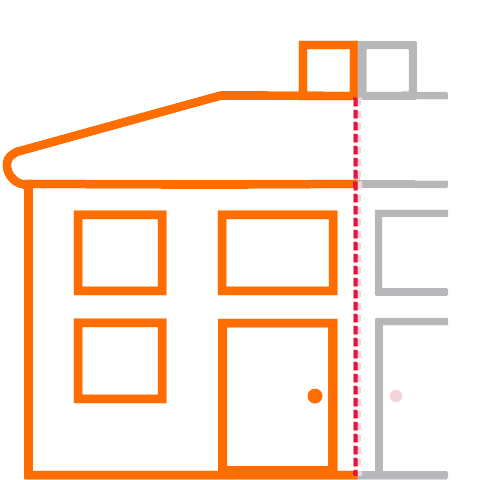While 400mm loft insulation isn't inherently harmful, it typically exceeds the industry-recommended standard of 270mm and may not be worth your investment. You'll encounter diminishing returns on energy efficiency beyond 270mm, and the extra thickness could potentially create moisture-related problems if your ventilation isn't adequate. Professional insulation experts generally advise against exceeding 300mm, as the marginal benefits don't justify the additional costs and installation complexities. Your focus should be on achieving balanced insulation throughout your home, considering factors like proper ventilation and moisture control. Understanding these key considerations will help you make an informed decision about your insulation needs.
Understanding Optimal Loft Insulation
Table of Contents
ToggleWhile many homeowners believe that more insulation always equals better performance, understanding ideal loft insulation isn't that straightforward. When you're considering increasing your loft insulation to 400mm, you'll need to weigh both the benefits and potential drawbacks of exceeding the recommended 270mm thickness.
You'll find that adding insulation beyond 270mm typically provides diminishing returns on your investment, as the marginal improvement in thermal performance becomes increasingly minimal.
What's more, you're risking the development of moisture-related issues if you over-insulate without maintaining proper ventilation. Before you decide to maximize your loft insulation, you'll want to evaluate your current insulation levels and consider how additional material might affect your home's overall thermal balance.
You should also remember that effective insulation isn't just about thickness in one area; it's about achieving the right balance throughout your home.
If you're uncertain about the best insulation thickness for your specific situation, you'll benefit from consulting with an insulation specialist who can assess your home's unique requirements and help you avoid potential complications from over-insulation.
Current Industry Standards
Industry standards for loft insulation have evolved considerably over the past few decades, settling on 270mm as the ideal thickness for most residential properties.
When you compare this to the modest 25-50mm recommendations of the 1980s, you'll see just how much our understanding of thermal efficiency has advanced.
While you might think that adding more insulation, such as increasing to 400mm, would provide better results, you'll find that the benefits diminish beyond the standard 270mm thickness.
You're likely to encounter a point of diminishing returns, where the additional cost of materials and installation won't justify the minimal improvement in energy efficiency.
What's more, you'll need to take into account the potential risks of over-insulation, as excessive thickness can lead to unwanted moisture issues and create conditions favorable for damp and mold growth.
If you're unsure about your property's insulation needs, you should consult with a qualified insulation expert.
They'll help guarantee that your installation meets current industry standards while bearing in mind your specific circumstances, helping you avoid both under-insulation and potential problems from over-insulation.
Benefits of Proper Insulation
Your home's energy efficiency hinges on proper loft insulation, delivering a range of compelling benefits that extend beyond simple heat retention. When you've installed insulation at the recommended thickness of 270mm, you'll notice a significant reduction in your energy bills while maintaining consistent indoor temperatures throughout the year.
You'll find that proper insulation thickness doesn't just save you money; it's also essential for preventing common household problems. By striking the right balance with your insulation depth, you're protecting your home from issues like damp and mold, which can occur when insulation is excessive and ventilation is compromised.
Additionally, you're contributing to environmental conservation by reducing your carbon footprint through decreased energy consumption for heating.
There's also a financial advantage you mightn't have considered: well-insulated properties are becoming increasingly valuable in today's real estate market. When you invest in appropriate loft insulation, you're not just improving your home's comfort and efficiency; you're enhancing its market appeal.
Property buyers are increasingly prioritizing energy-efficient homes, making your investment in proper insulation a smart long-term financial decision.
Signs of Over-Insulation
Over time, excessive loft insulation can reveal itself through several telltale signs that shouldn't be ignored. If you've installed insulation thicker than 270mm, particularly up to 400mm, you'll want to watch for specific indicators that suggest you may have gone too far with your insulation efforts.
One of the most common signs you'll notice is increased condensation forming on your windows and walls. This occurs because the excessive insulation can prevent proper ventilation, trapping moisture within your home.
You might also detect a musty odor emanating from your loft space, which often indicates the presence of trapped moisture leading to damp conditions. When these warning signs appear, you're likely experiencing diminishing returns on your insulation investment, as thickness beyond 270mm typically offers minimal additional thermal benefits.
If you're spotting these indicators, it's essential that you don't ignore them. The trapped moisture can eventually lead to mold growth and structural damage in your home.
You'll want to consult with an insulation specialist who can assess your situation and recommend appropriate solutions, ensuring your home maintains a proper balance of insulation throughout all areas.
Measuring Your Loft Space
Before adding any insulation to combat over-insulation issues, taking accurate measurements of your loft space will help you make informed decisions about material quantities.
You'll need to measure both the length and width in meters, multiplying these figures to determine your loft's total area in square meters.
When you're evaluating your insulation needs, you'll want to inspect any existing insulation layers and measure their depth.
Standard insulation rolls cover approximately 6.45m² per roll, with dimensions of 1.14 meters wide by 5.68 meters long at 170mm thickness.
You'll need to factor in the current insulation depth when calculating how much additional material you'll need to reach the recommended 270mm total thickness.
To calculate the number of rolls required, divide your total loft area by the coverage area per roll (6.45m²).
It's crucial to be precise with these measurements, as accurate calculations will prevent you from purchasing too much or too little material.
Consider using a specialized calculator or reference table to double-check your calculations, ensuring you'll achieve ideal insulation levels without exceeding necessary thickness requirements.
Cost Analysis and Considerations
The cost implications of installing 400mm loft insulation deserve careful scrutiny, as they often outweigh potential benefits.
You'll find that while the standard 270mm thickness provides ideal insulation, increasing to 400mm requires significant additional investment without proportional returns on energy efficiency. At £20 per roll of insulation material, you're looking at considerable extra expenses for marginal thermal improvements.
When you factor in professional installation costs of around £300, the financial commitment becomes even more substantial.
You'll need to carefully weigh whether these costs align with your expected energy savings, particularly since the additional thickness may not deliver meaningful thermal benefits beyond the recommended 270mm.
What's more concerning is that you're potentially risking costly complications, as over-insulation can create favorable conditions for damp and mold development. These issues could lead to expensive remediation work down the line.
Before proceeding with 400mm insulation, you should consult qualified insulation specialists who can assess your specific situation.
They'll help you determine whether exceeding the recommended thickness is justifiable for your home, considering both immediate expenses and long-term financial implications.
Installation Best Practices
While installing loft insulation might seem straightforward, proper technique guarantees top performance and prevents potential issues.
You'll need to begin by measuring your existing insulation depth carefully, which helps determine how much additional material you'll require to achieve ideal thermal efficiency.
When you're layering insulation, it's vital to stagger the joints between layers, as this reduces thermal bridging and guarantees consistent performance across your entire loft space.
You shouldn't automatically assume that 400mm is your target thickness, as the ideal depth depends on various factors specific to your home. The key is finding the right balance, as 270mm often provides excellent insulation while avoiding potential moisture problems that can occur with excessive thickness.
You'll want to select your insulation material based on your loft's specific characteristics, as different types of insulation perform differently at various thicknesses.
If you're uncertain about the appropriate thickness or installation method for your situation, it's worth consulting an insulation specialist who can assess your home's particular requirements and provide targeted recommendations for ideal results.
Ventilation and Moisture Control
Maintaining proper ventilation becomes increasingly critical when installing thick loft insulation, as excessive layers can trap moisture and create ideal conditions for dampness and mold growth.
When you're considering 400mm of insulation, which exceeds the recommended 270mm thickness, you'll need to pay particular attention to your ventilation strategy.
You'll want to guarantee that air can flow freely throughout your loft space, and the most effective approach is to install vents at both the eaves and ridge positions. This creates a natural circulation pattern that helps prevent moisture from becoming trapped beneath your insulation.
It's crucial to monitor your loft's relative humidity levels, and if you notice readings above 60%, you're likely facing ventilation issues that need immediate attention.
Before proceeding with thick insulation installation, you'd be wise to consult an insulation specialist who can assess your specific situation.
They'll help you develop a balanced approach that maintains effective insulation while guaranteeing proper airflow.
Energy Efficiency Trade-offs
Increasing loft insulation beyond 270mm reveals an essential principle in energy efficiency: the law of diminishing returns. While you might assume that adding more insulation will proportionally increase your energy savings, the reality is that pushing beyond the recommended thickness yields minimal additional benefits.
When you're thinking about upgrading to 400mm of loft insulation, you'll need to weigh several important trade-offs. The marginal energy savings you'll achieve don't always justify the additional investment, and you may actually create new problems in your home.
Insulation experts typically recommend staying at or below 300mm, as this represents the ideal balance between thermal performance and building health. You'll want to keep in mind that excessive insulation can trap moisture, potentially leading to condensation issues that could damage your property over time.
Instead of focusing solely on maximizing loft insulation, you'll get better results by taking a whole-house approach to energy efficiency. This means evaluating heat loss through other areas like windows, doors, and walls, and developing a balanced insulation strategy that addresses all these elements systematically through regular assessments and targeted improvements.





